Highlands and Islands: Rural backwater to industrial powerhouse

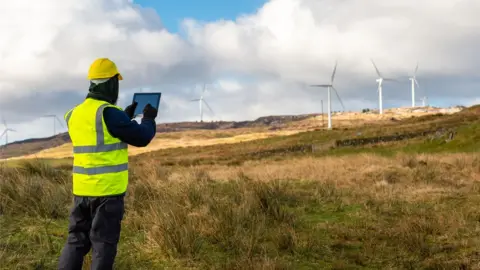 Getty Images
Getty Images- These are good times for the Highlands and Islands. The pressures on transport and housing stem from the opportunities for growth - a reverse after many decades of decline.
- The case for better transport and telecoms infrastructure is made by its transformational successes in the past.
- The biggest potential is from renewable energy. But do Highlanders and islanders realise the scale of what's about to happen to their region?
It's the size of Belgium, they tell you, though the similarities stop around there. Much of the region has sparse population and is designated 'less favoured area' for the quality of its agricultural land.
However, it's more favoured for its tourism appeal, in an industry given booster rockets by the power of Instagram. It has many of Scotland's most important food and drink successes, and many more of its answers to the climate emergency.
The Highlands and Islands economy has long been seen as a drain of people and talent, or an expensive drain on funds. But that has changed, and the region is on the cusp of changing much faster, as a renewable powerhouse for the UK and beyond, and even as a launchpad for space.
That potential was reflected in the next five-year strategy for Highlands and Islands Enterprise (HIE), published this week.
It's not long after the first anniversary of my move from Glasgow to the Black Isle, so it has had me reflecting on what I've learned since that flit.
The HIE strategy reflects changes afoot in the economy - space launchpads, marine bio-technology, more potential for the creative industries.
Not only does the agency see Net Zero as an opportunity, it plans to make a credible commitment to reducing emissions as a condition for support to a business client.
But the Scottish government's economic agency is coy and reticent about the most contentious political issue for the area, of transport.
"Major transport and digital connectivity improvements have been made over past decades and the region is well-connected, but there is room for improvement," it understates.
Rest and Be Thankful
In the northern isles, the inter-island ferries are in need of replacement, and islanders are asking why more of the bill isn't picked up at national level.
It's no coincidence that Orcadians have been wondering out loud if they might be better off as part of Norway. Shetland has a bold plan for tunnels to replace several ferries. If the Faroes can, why not?
The problems of the CalMac ferry fleet to the west are widely known - an ageing fleet, huge problems with replacement vessels, far too many cancelled services and, with fares reduced to match the equivalent cost of road travel, demand outstrips capacity for much of the summer.
Rail services are little faster than taking the car. The Scottish government says it intends to electrify the main line between Perth and Inverness by 2035.
That target, set in 2020, is a reminder of the one for dualling the A9 road between the two cities. It never had a credible plan, the target has slipped so far that it's been abandoned and we should hear of a new target soon. This time, it could even be backed by action.
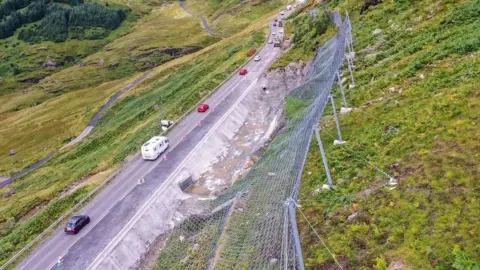 Transport Scotland
Transport ScotlandThe A9 gets a lot of the attention, as a vital corridor. But the bottlenecks and road design are worse on the A82 along Loch Lomond-side, which is a vital connection for Lochaber.
There are repeated landslips blocking the A83 at the Rest and Be Thankful in Argyll. That is not a remote Highland road as some might suppose. It's the vital artery for the economy of most of Argyll, through Invererary, Lochgilphead and on to Campbeltown.
The A96 between Inverness and Aberdeen, an important link for agriculture, distillers, tourism and the energy sector, is also crying out for more capacity and bypasses.
'Visionary'
The case for improved transport infrastructure is there for all to see. It has come in waves. Most Highland settlements grew up around railway stations.
Anyone who recalls the tortuous A9 road between Perth and Inverness before 1975 or so - bottlenecked through villages and corkscrewing under rail bridges - will be aware what a huge improvement and difference it made to opening up the Highland capital for economic development.
Even clearer was the impact of three bridges to open up the Moray Firth area north of Inverness. The Kessock bridge from the city to the Black Isle transformed the peninsula (no, it's not an isle). At its furthest point east, Cromarty was becoming derelict in the 1970s, and is now an architectural and cultural gem.
The Cromarty bridge bypassed Dingwall and opened up the possibilities for Easter Ross, and a further bridge across the Dornoch Firth brought Sutherland into the Inverness travel-to-work region.
David Bell, an economics professor who retired from Stirling University to return to his Dornoch roots two years ago, says those bridges were "visionary". He adds that the case for improved A9 should be extended north of Inverness as energy traffic comes to Easter Ross.
Ageing Highlanders
It's not all about the Inverness area. A big part of the Highlands and Islands success story of the past 50 years flowed from European structural funds. Bridges and causeways brought life back to the Outer Hebridean islands of Scalpay, Berneray, Vatersay and Eriskay.
The funds helped build the fibre infrastructure that linked eight colleges into the University of the Highlands and Islands. That has helped some stay at home to be educated and upskilled - if they can secure and afford homes.
But it would be wrong to say that has reversed the brain drain of young people from the region. The bright lights of central belt cities and their universities still shine more brightly.
One of the more significant challenges faced by the north and west now is a rapid demographic tilt away from families and towards retirees. School rolls are projected to fall steeply, changing the nature of the economy and putting pressure on other public services including health and social care.
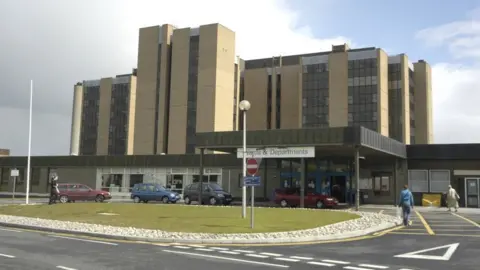
Local politicians have recently begun a campaign to replace Raigmore Hospital in Inverness, aware it's unlikely during their careers. But further centralisation of services is a big issue in more remote west coast communities.
Skye has seen a long campaign to retain services in the north of the island. If you're not familiar with the island, it's probably bigger than you think, the moreso if you need medical help in a hurry.
'Just transition'
The list of challenges goes on. I haven't mentioned uncertainty around farming subsidies and potential no-fishing zones, or the pressure on roads and services from the marketing success of the North Coast 500.
But the list of opportunities has been growing fast too. The HIE report highlights the relatively high level of high growth companies and (at least female) entrepreneurial activity.
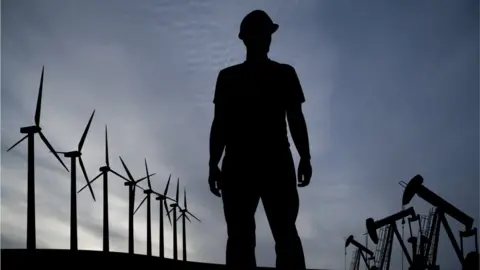 Getty Images
Getty ImagesAlthough the area has many of the not-spots for broadband and mobile connectivity, where it works, it transforms possibilities for remote working and for delivery of public services.
And the biggest prospect is energy. A recent study by the Institute of Fiscal Studies showed that falling income from oil and gas has hit the north of Scotland harder than other parts.
That's not just Aberdeen, the north-east and Shetland, but across the Highlands and Islands. Numerous small communities have been sustained for decades by good earnings from offshore work.
The 'just transition' being promised for those workers with the move to renewable power has its sceptics. It doesn't look like the jobs bonanza that oil brought, or at least not the pay bonanza that came with those jobs.
But there's world leadership on tidal power in the Pentland Firth, Shetland and Islay, pumped-storage hydro being expanded at Ben Cruachan and around Loch Ness, perhaps eventually wave power from its research base on Orkney and, yes, even the installation of two solar arrays in Moray.
ScotWind
The biggest prospect is in wind power - 're-powering' older onshore turbines with much taller, more powerful designs - and ScotWind.
The scale of it could be colossal, in 17 sea areas installing hundreds of vast turbines, some on platforms, but many floating and anchored to the seabed, using technologies which open up vast new areas of the sea.
Developers have paid nearly £800m for the right to develop, and if the pricing incentives and cost of finance align, they could be building out capacity - in this round of development alone - of more than three times the usual power demand from Scottish customers.
Like the oil and gas industry, most of this will be over the horizon. Also like fossil fuels, many of the jobs will be in onshore engineering and support. The Green Freeport status secured by Cromarty Firth and Inverness is still taking shape, but could bring very significant industrialisation to the area.
 MALCOLM MCCURRACH/NEW WAVE IMAGES UK
MALCOLM MCCURRACH/NEW WAVE IMAGES UKNigg is ready for such work, and there are plans for a large cable factory on adjacent land. But much more capacity for assembling offshore equipment is required. In Wester Ross, another former oil platform fabrication yard at Loch Kishorn is back in action.
At Ardersier near Inverness, an area the size of 300 football pitches is being cleared and a deep quayside installed.
That £300m US investment in the new company in charge there, Hiventus, is merely a down-payment. Far more is expected on the site, including manufacturing. The big aim remains a factory for the high-skilled jobs in making blades.
It's a reminder, raised also by Professor David Bell, of one of the bigger challenges for this and other business development: the importance of ready access to capital.
Pylons galore
Unlike oil and gas, there's a big challenge from the renewable power expansion in getting power to the customer.
Some will draw industries into the region for local use, with the biggest potential for cracking water to isolate burnable hydrogen.
Big international markets are opening up for hydrogen as an industrial fuel to replace oil and gas. Pipelines and shipping terminals will be required.
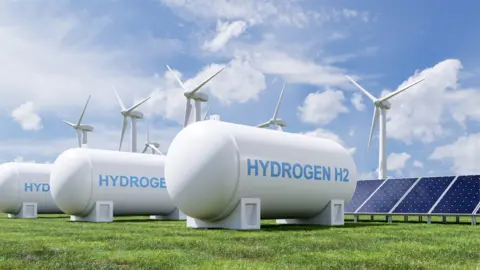 Getty Images
Getty ImagesFor homes and businesses in the central belt, England and beyond, some power will go through subsea cables, but much of it will be on high pylons, which are meeting fierce opposition in the Highlands as well as points further south.
So a year after moving to the Black Isle, what are my reflections? It's a fantastic place to live, for quality of life and strong communities. There are worries and pressures in common with other parts of the country, but there is a confidence in the air.
These are good times for the Highlands and Islands. The challenges of transport and housing stem from the prospects for growth, rather than depopulation and decline that characterised the area before the 1960s.
When I look at the scale of what is coming from the Great Energy Transition, I wonder if Highlanders and islanders are yet aware how much that could industrialise these largely rural areas, and move them from the periphery to the heart of the new economy.
